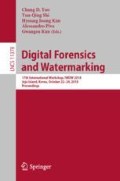Abstract
Watermarks are often used to protect copyright-protected videos from illegal re-distribution. More specifically, a unique watermark that represents the receiver’s identifier is embedded into the video. In this way, malicious users can be identified when they leak their received version of the video. However, when the watermark is embedded as visible text in the video, it is easy for digital pirates to delete it such that they can no longer be identified. Therefore, copyright owners will benefit from a technique that allows the detection of a visible watermark when it is removed. This paper demonstrates how a visible watermark indirectly generates imperceptible variations over the entire video. As such, these variations in the non-watermarked area can be used as an alternative watermark representation, and thus enable watermark detection even after watermark removal. The experimental results prove that the watermark can be detected as long as the quality of the watermarked video is not significantly reduced, especially if the originally-distributed watermarked video has a high quality. Moreover, the watermark should be embedded into a video with sufficient motion. In conclusion, the proposed technique enables copyright-owners to identify pirates when they illegally distribute visibly-watermarked videos, even when the watermarked area is removed.
This work was funded by the Research Foundation – Flanders (FWO) under Grant 1S55218N, IDLab (Ghent University – imec), Flanders Innovation & Entrepreneurship (VLAIO), and the European Union. Furthermore, the computational resources (STEVIN Supercomputer Infrastructure) and services used in this work were kindly provided by Ghent University, the Flemish Supercomputer Center (VSC), the Hercules Foundation and the Flemish Government department EWI.
Access this chapter
Tax calculation will be finalised at checkout
Purchases are for personal use only
References
Asikuzzaman, M., Pickering, M.R.: An overview of digital video watermarking. IEEE Trans. Circuits Syst. Video Technol. (2017). https://doi.org/10.1109/TCSVT.2017.2712162
Bossen, F.: Common test conditions and software reference configurations. Technical report, JCTVC-L1100, ITU-T Joint Collaborative Team on Video Coding (JCT-VC), January 2013
Cox, I., Miller, M., Bloom, J., Fridrich, J., Kalker, T.: Digital Watermarking and Steganography, 2nd edn. Morgan Kaufmann Publishers, San Francisco (2008)
Feng, B., Weng, J., Lu, W.: Improved algorithms for robust histogram shape-based image watermarking. In: Kraetzer, C., Shi, Y.Q., Dittmann, J., Kim, H.J. (eds.) IWDW 2017. LNCS, vol. 10431, pp. 275–289. Springer, Berlin (2017). https://doi.org/10.1007/978-3-319-64185-0_21
Hartung, F., Girod, B.: Watermarking of uncompressed and compressed video. Signal Process. 66(3), 283–301 (1998)
Hu, Y., Kwong, S., Huang, J.: Using invisible watermarks to protect visibly watermarked images. In: Proceedings of IEEE International Symposium Circuits Systems (ISCAS). vol. 5, pp. V-584–V-587, May 2004
Huang, C.H., Wu, J.L.: Inpainting attacks against visible watermarking schemes. In: Proceedings of SPIE, vol. 4314 (2001). https://doi.org/10.1117/12.435421
Huang, C.H., Wu, J.L.: Attacking visible watermarking schemes. In: Proceedings of IEEE International Conference on Multimedia Computing Systems (ICMCS), vol. 6, no. 1, pp. 16–30, Feburary 2004. https://doi.org/10.1109/TMM.2003.819579
Kankanhalli, M.S., Ramakrishnan, K.R.: Adaptive visible watermarking of images. In: Proceedings of IEEE International Conference on Multimedia Computing Systems (ICMCS), vol. 1, pp. 568–573, July 1999. https://doi.org/10.1109/MMCS.1999.779263
Mareen, H., De Praeter, J., Van Wallendael, G., Lambert, P.: A novel video watermarking approach based on implicit distortions. IEEE Trans. Consum. Electron. 64(3), 250–258 (2018). https://doi.org/10.1109/TCE.2018.2852258
Mohanty, S.P., Ramakrishnan, K.R., Kankanhalli, M.: A dual watermarking technique for images. In: Proceedings of ACM International Conference on Multimedia, pp. 49–51. ACM, New York (1999). https://doi.org/10.1145/319878.319891
Siddique, H.: Game of thrones fifth season episodes leaked online. The Guardian, 12 April 2015. https://www.theguardian.com/tv-and-radio/2015/apr/12/game-of-thrones-fifth-season-episodes-leaked-online
Sullivan, G.J., Ohm, J.R., Han, W.J., Wiegand, T.: Overview of the high efficiency video coding (HEVC) standard. IEEE Trans. Circuits Syst. Video Technol. 22(12), 1649–1668 (2012). https://doi.org/10.1109/TCSVT.2012.2221191
Tew, Y., Wong, K.: An overview of information hiding in H.264/AVC compressed video. IEEE Trans. Circuits Syst. Video Technol. 24(2), 305–319 (2014). https://doi.org/10.1109/TCSVT.2013.2276710
Wong, P.W.: A watermark for image integrity and ownership verification. In: Proceedings of IS&TS PICS, pp. 374–379. Society for Imaging Science & Tehnology (1998)
Yang, G., Qi, W., Li, X., Guo, Z.: Improved reversible visible watermarking based on adaptive block partition. In: Kraetzer, C., Shi, Y.Q., Dittmann, J., Kim, H.J. (eds.) IWDW 2017. LNCS, vol. 10431, pp. 303–317. Springer, Berlin (2017). https://doi.org/10.1007/978-3-319-64185-0_23
Zhang, X., Wang, Z.J.: Correlation-and-bit-aware multiplicative spread spectrum embedding for data hiding. In: Proceedings of IEEE International Workshop Information Forensics Security (WIFS), pp. 186–190, November 2013. https://doi.org/10.1109/WIFS.2013.6707816
Author information
Authors and Affiliations
Corresponding author
Editor information
Editors and Affiliations
Rights and permissions
Copyright information
© 2019 Springer Nature Switzerland AG
About this paper
Cite this paper
Mareen, H., De Praeter, J., Van Wallendael, G., Lambert, P. (2019). Traitor Tracing After Visible Watermark Removal. In: Yoo, C., Shi, YQ., Kim, H., Piva, A., Kim, G. (eds) Digital Forensics and Watermarking. IWDW 2018. Lecture Notes in Computer Science(), vol 11378. Springer, Cham. https://doi.org/10.1007/978-3-030-11389-6_9
Download citation
DOI: https://doi.org/10.1007/978-3-030-11389-6_9
Published:
Publisher Name: Springer, Cham
Print ISBN: 978-3-030-11388-9
Online ISBN: 978-3-030-11389-6
eBook Packages: Computer ScienceComputer Science (R0)

